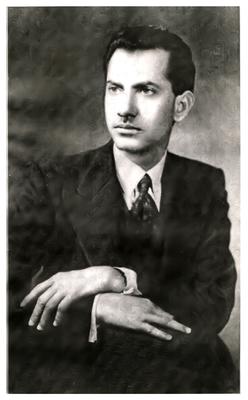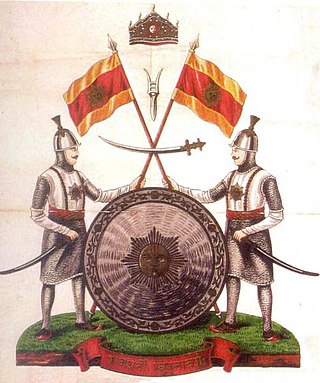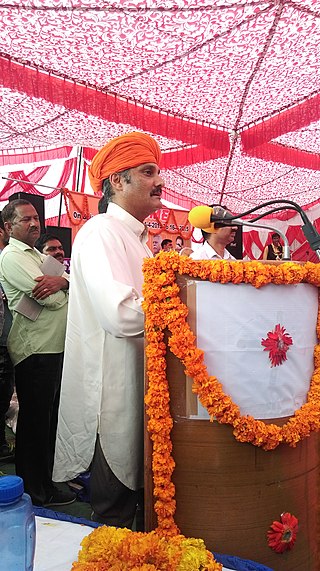
Srinagar is a city in Indian-administered Jammu and Kashmir in the disputed Kashmir region. It is the largest city and summer capital of Jammu and Kashmir, which is an Indian-administered union territory. It lies in the Kashmir Valley along the banks of the Jhelum River, and the shores of Dal Lake and Anchar Lakes, between the Hari Parbat and Shankaracharya hills. The city is known for its natural environment, various gardens, waterfronts and houseboats. It is also known for traditional Kashmiri handicrafts like the Kashmir shawl, papier-mâché, wood carving, carpet weaving, and jewel making, as well as for dried fruits. It is the second-largest metropolitan area in the Himalayas.

Maharaja Sir Hari Singh was the last ruling Maharaja of the princely state of Jammu and Kashmir.

Maharaja Gulab Singh Jamwal (1792–1857) was the founder of Dogra dynasty and the first Maharaja of the princely state of Jammu and Kashmir, which was a part of Sikh Empire became the largest princely state under the British Raj, which was created after the defeat of the Sikh Empire in the First Anglo-Sikh War. During the war, Gulab Singh would later side with the British and end up becoming the Prime Minister of Sikh Empire. The Treaty of Amritsar (1846) formalised the transfer of all the lands in Kashmir that were ceded to them by the Sikhs by the Treaty of Lahore.

Sardar Muhammad Ibrahim Khan was a revolutionary leader and politician from the western region of Jammu and Kashmir, who led the 1947 Poonch Rebellion against the Maharaja in the state of Jammu and Kashmir and played a key role in the First Kashmir War, supporting Pakistan. He served as the President of Azad Kashmir for 13 years across four non-consecutive terms and still remains the longest-serving president of the state, since its establishment.

Pratap Singh was the Maharaja of Jammu and Kashmir, and head of the Jamwal Rajput clan of the ruling Dogra dynasty.

Jamwal is a toponymic surname for a Dogra Rajput clan of the same name from Jammu, in Jammu and Kashmir, India. They claim descent from the traditional founder of Jammu, Jambu Lochan, and there at one time some of their members were rulers of the princely state of Jammu and Kashmir, often referred to as the Dogra dynasty.

The Amar Mahal Palace is a palace in Jammu, in the Indian erstwhile Kingdom of Jammu and Kashmir, India. The palace has now been converted into a museum. Commissioned by Maharaja Amar Singh, a Dogra king, the palace was built in the nineteenth century by a French architect on the lines of a French Chateau. The palace was donated to the Hari-Tara Charitable Trust by Karan Singh for use as a museum. It has many exhibits including a golden throne weighing 120kg, a Pahari miniature, Kangra miniature paintings, a library of 25,000 antique books, many rare art collections, and a large collection of portraits of the royal family.

The Dogra dynasty of Dogra Rajputs from the Shivalik hills created Jammu and Kashmir through the treaties with the East India Company following the First Anglo-Sikh war. Events led the Sikh Empire to recognise Jammu as a vassal state in 1820, and later the British added Kashmir to Jammu with the Treaty of Amritsar in 1846. The founder of the dynasty, Gulab Singh, was an influential noble in the court of the Sikh emperor Maharaja Ranjit Singh, while his brother Dhian Singh served as the prime minister of the Sikh Empire. Appointed by Ranjit Singh as the hereditary Raja of the Jammu principality, Gulab Singh established his supremacy over all the hill states surrounding the Kashmir Valley. After the First Anglo-Sikh War in 1846, under the terms of the Treaty of Lahore, 1846, the British East India Company acquired Kashmir from the Sikh Empire and transferred it to Gulab Singh, recognising him as an independent Maharaja. Thus, Jammu and Kashmir was established as one of the largest princely states in India, receiving a 21-gun salute for its Maharaja in 1921. It was ruled by Gulab Singh and his descendants until 1947.

Poonch District was a district of the princely state of Jammu and Kashmir, which is currently divided between India and Pakistan. The Pakistani part of the erstwhile district is now the Poonch Division in the Azad Kashmir territory, whilst the Indian part of the district is the Poonch district in Jammu and Kashmir. The capital of the Pakistan-controlled side is Rawalakot; while the capital of the Indian-controlled side is Poonch.

The City Palace, Jaipur is a royal residence and former administrative headquarters of the rulers of the Jaipur State in Jaipur, Rajasthan. Construction started soon after the establishment of the city of Jaipur under the reign of Maharaja Sawai Jai Singh II, who moved his court to Jaipur from Amber, in 1727. Jaipur remained the capital of the kingdom until 1949—when it became the capital of the present-day Indian state of Rajasthan—with the City Palace functioning as the ceremonial and administrative seat of the Maharaja of Jaipur. The construction of the Palace was completed in 1732 and it was also the location of religious and cultural events, as well as a patron of arts, commerce, and industry. It was constructed according to the rules of vastushastra, combining elements of Mughal and Rajput architectural styles. It now houses the Maharaja Sawai Man Singh II Museum, and continues to be the home of the Jaipur royal family. The royal family has around 500 personal servants. The palace complex has several buildings, various courtyards, galleries, restaurants, and offices of the Museum Trust.The MSMS II Museum Trust is headed by chairperson Rajamata Padmini Devi of Jaipur. Princess Diya Kumari runs the Museum Trust, as its secretary and trustee. She also manages The Palace School and Maharaja Sawai Bhawani Singh School in Jaipur. She founded and runs the Princess Diya Kumari Foundation to empower underprivileged and underemployed women of Rajasthan. She is also an entrepreneur. In 2013, she was elected as Member of the Legislative Assembly of Rajasthan from the constituency of Sawai Madhopur.
Accession Day is a public holiday in the Union Territory of Jammu and Kashmir, commemorating 26 October 1947, when Maharaja Hari Singh signed off the Instrument of Accession, in which Jammu and Kashmir joined the Dominion of India. It became an official public holiday in Jammu and Kashmir for the first time in 2020.

The Sher Garhi Palace is a historic royal residence in Srinagar, Jammu and Kashmir, India. Situated south of the Old City of Srinagar, along the banks of the Jhelum River, its name,"Sher Garhi," translates to "Fort of the Lion,"highlighting its role as a prominent seat of power. Initially constructed in 1772 by Afghan governor Jawansher Khan, it served as the residence of Afghan rulers before becoming home to the Dogra Maharajas of Jammu and Kashmir.
Gulab Bhavan is a palace in Srinagar, India. It is a former residence of the maharaja of Jammu and Kashmir from the Dogra dynasty. The palace is in the eastern part of the city and overlooks the Dal Lake.

Mubarak Mandi is a palace complex located in the heart of the old walled city of Jammu in Jammu and Kashmir, India. Built over several centuries, starting in 1824, the complex served as the principal seat of the Dogra dynasty, which ruled the region as maharajas of Jammu and Kashmir until the mid-20th century. The palace was the Maharajas main seat till 1925, when maharaja Hari Singh moved to the Hari Niwas Palace in the northern part of Jammu. Overlooking the Tawi River, this sprawling complex showcases an impressive fusion of architectural styles, combining elements of Rajasthani, Mughal, and European baroque influences. The complex comprises multiple palaces, courtyards, and halls, including the notable Darbar Hall, Gol Ghar, Pink Palace, and Sheesh Mahal, each with unique features and functions. Successive maharajas added to the complex in size and building took more than 150 years.

The Royal Springs Golf Course is a public golf course located near Chashme Shahi overlooking Dal Lake in Srinagar, Kashmir.

The Jammu–Sialkot line was a 43 km (27 mi) broad gauge branch of the North Western State Railway from Wazirabad Junction, Punjab, to Jammu, passing through the Sialkot Junction. The section from Sialkot to Jammu (Tawi) was 27 miles (43 km) long, partly in the British Indian province of Punjab and partly in the princely state of Jammu and Kashmir Built in 1890 during the reign of Maharaja Pratap Singh, it was the first railway line in the state of Jammu and Kashmir.

Amar Singh College, is an academic and professional college in Srinagar, Jammu and Kashmir, India. It is the second oldest college in the Kashmir Valley after Sri Pratap College.
Amar Singh Club Ground is ground in Srinagar, Jammu and Kashmir. The ground is part of the Amar Singh Club which was in the year 1933. The ground was named memory of after Raja Amar Singh by his son Maharaja Hari Singh. The ground is located in the 10 acre of land with facilities of one tennis court, badminton court and two Squash courts as well as 12 rooms. The ground has hosted cricket matches from 1960 and 1999 since then cricket in not played the ground. The ground was home of Jammu and Kashmir cricket team when they made a first-class debut and hosted 39 matches as well as a List A matches.

YuvrajVikramaditya Singh is an Indian businessman and politician. He was a leader of Indian National Congress (INC) and an ex-member of Jammu and Kashmir Legislative Council. He is the grandson of Maharaja Sir Hari Singh, who was the last ruler of the Indian princely state of Kashmir. He is the heir apparent of the Dogra dynasty.
Chitrangada Singh is an Indian businesswoman and a descendant of the former ruling family of a major princely state during the British Raj in India.
















